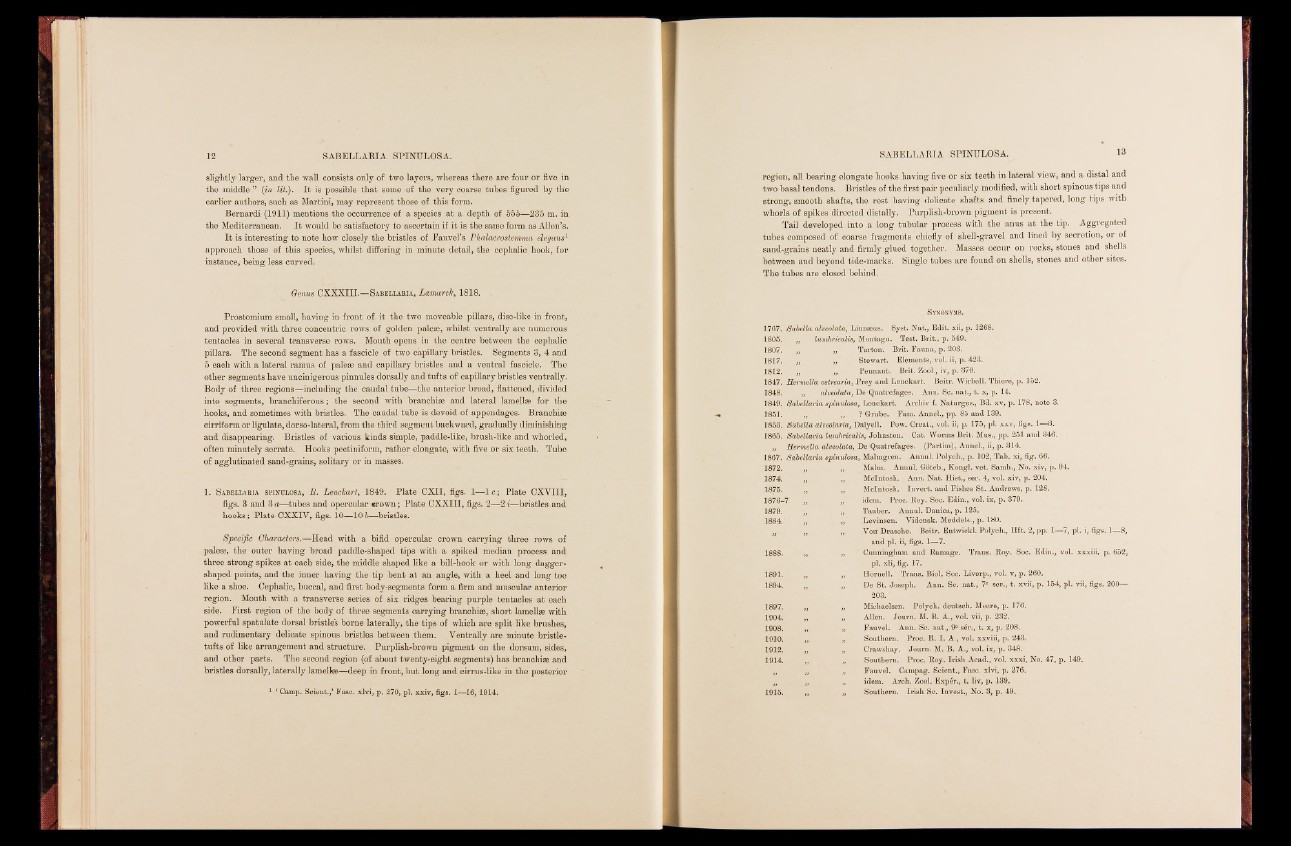
slightly larger, and the wall consists only of two layers, whereas there are four or five in
the middle ” (in lit.). It is possible that some of the very coarse tubes figured by the
earlier authors, such as Martini, may represent those of this form.
Bemardi (1911) mentions the occurrence of a species at a depth of 555—235 m. in
the Mediterranean. It would be satisfactory to ascertain if it is the same form as Allen’s.
It is interesting to note how closely the bristles of Fauvel’s Phalacrostemma elegans1
approach those of this species, whilst differing in minute detail* the cephalic hook, for
instance, being less curved.
Genus CXXXIII.—Sabellabia, Lamarck, 1818.
Prostomium small, having in front of it the two moveable pillars, disc-like in front,
and provided with three concentric rows of golden palese, whilst ventrally are numerous
tentacles in several transverse rows. Mouth opens in the centre between the cephalic
pillars. The second segment has a fascicle of two capillary bristles. Segments 3, 4 and
5 each with a lateral ramus of palese and capillary bristles and a ventral fascicle. The
other segments have uncinigerous pinnules dorsally and tufts of capillary bristles ventrally.
Body of three regions—including the caudal tube—the anterior broad, flattened, divided
into segments, branchiferous; the second with branchias and lateral lamellse for the
hooks, and sometimes with bristles. The caudal tube is devoid of appendages. Branchiae
cirriform or ligulate, dorso-lateral, from the third segment backward, gradually diminishing
and disappearing. Bristles of various kinds simple, paddle-like, brush-like and whorled,
often minutely serrate. Hooks pectiniform, rather elongate, with five or six teeth. Tube
of agglutinated sand-grains, solitary or in masses.
1. Sabellabia spinulosa, B. Leuckart, 1849. Plate CXII, figs. 1—lc ; Plate CXVIII,
figs. 3 and 3 a—tubes and opercular erown; Plate CXXIII, figs. 2—2 i—bristles and
hooks; Plate CXXIY, figs. 10—10 6—bristles.
Specific Characters.—Head with a bifid opercular crown carrying three rows of
palese, the outer having broad paddle-shaped tips with a spiked median process and
three strong spikes at each side, the middle shaped like a bill-hook or with long daggershaped
points, and the inner having the tip bent at an angle, with a heel and long toe
like a shoe. Cephalic, buccal, and first body-segments form a firm and muscular anterior
region. Mouth with a transverse series of six ridges bearing purple tentacles at each
side. First region of the body of three segments carrying branchiae, short lamellae with
powerful spatulate dorsal bristles borne laterally, the tips of which are split like brushes,
and rudimentary delicate spinous bristles between them. Ventrally are minute bristle-
tufts of like arrangement and structure. Purplish-brown pigment on the dorsum, sides,
and other parts. The second region (of about twenty-eight segments) has branchiae and
bristles dorsally, laterally lamelke—deep in front, but long and. cirrus-like in the posterior
‘Camp. Scient./ Fase, xlvi, p. 270, pi. xxiv, figs. 1—16, 1914.
region, all bearing elongate hooks having five or six teeth in lateral view, and a distal and
two basal tendons. Bristles of the first pair peculiarly modified, with short spinous tips and
strong, smooth shafts, the rest having delicate shafts and finely tapered, long tips with
whorls of spikes directed distally. Purplish-brown pigment is present.
Tail developed into a long tubular process with the anus at the tip. Aggregated
tubes composed of coarse fragments chiefly of shell-gravel and lined by secretion, or of
sand-grains neatly and firmly glued together. , Masses occur on rocks, stones and shells
between and beyond tide-marks. Single tubes are found on shells, stones and other sites.
The tubes are closed behind.
Synonyms.
1767.
1805.
1807.
1817.
1812.
1847.
1848.
1849.
1851.
1853.
1865.
1867.
1872.
1874.
1875.
1876-
1879.
1891.
1894.
Sabella alveolata, Linnæus. Syst. Nat., Edit, xii, p. 1268.
; . lumbricalis, Montagu. Test. Brit., p. 549.
' „ Turton. Brit. Fauna, p. 203.
„ ,, Stewart. Elements, vol. ii, p. 423.
» Pennant. Brit. Zool., iv, p. 370.
Hermelin ostrearia, Frey and Leuckart. Beitr. Wirhell. Thiere, p. 152.
„ alveolata, De Quatrefages. Ann. Sc. nat., t. x, p. 14.
Sabellaria spinulosa, Leuckart. Archiv f. Naturges., Bd. xv, p. 178, note 3.
„ . „ ? Grübe. Fam. Annel., pp. 85 and 139.
Sabella alveolaria, Dalyell. Pow. Créât., vol. ii, p. 175, pi. xxv, figs. 1—3.
Sabellaria lumbricalis, Johnston. Cat. Worms Brit. Mus., pp. 251 and 346.
Hermella alveolata, De Quatrefages. (Partim), Annel., ii, p. 314.
Sabellaria spinulosa, Malmgren. Annul. Polych., p. 102, Tab. xi, fig. 66.
}) . )} Malm. Annul. Göteb., Kongl. vet. Samh., No. xiv/p. 94.
)} „ McIntosh. Ann. Nat. Hist., ser. 4, vol. xiv, p. 204.
,, McIntosh. Invert, and Fishes St. Andrews, p. 128.
i—7 „ ' „ idem. Proc. Roy. Soc. Edin., vol. ix, p. 379.
,, Tauber. Annul. Danica, p. 125.
„ Levinsen. Vidensk. Meddels., p. 180.
„ Von Dräsche. Beitr. Entwickl. Polych., Hft. 2, pp. lH§j|j pi. i, figs. 1—8,
and pi. ii, figs. 1—7.
„ Cunningham and Ramage. ’Trans. Roy. Soc. Edin., vol. xxxiii, p. 652,
pi. xli, fig. 17.
„ Hornell. Trans. Biol. Soc. Liverp., vol. v, p. 260.
„ De St. Joseph. Ann. Sc. nat., 7° ser., t. xvii, p. 154, pi. vii, figs. 200—
203.
1897.
1904.
1908.
1910.
191,2.
1914.
Michaelsen. Polych. deutsch. Meere, p. 176.
Allen. Journ. M. B. A., vol. vii, p. 232.
Fauvel. Ann. Sc. nat., 9e sér., t. x, p. 208.
Southern. Proc. R. I. A., vol. xxviii, p. 243.
Crawshay. Journ. M. B. A., vol. ix, p. 348.
Southern. Proc. Roy. Irish Acad., vol. xxxi, No. 47, p. 149.
Fauvel. Campag. Scient., Fasc. xlvi, p. 276.
idem. Arch. Zool. Expér., t. liv, p. 139.
Southern. Irish Sc. Invest., No. 3, p. 49. .